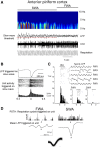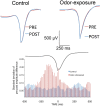Single-unit activity in piriform cortex during slow-wave state is shaped by recent odor experience
- PMID: 20130185
- PMCID: PMC2830815
- DOI: 10.1523/JNEUROSCI.5636-09.2010
Single-unit activity in piriform cortex during slow-wave state is shaped by recent odor experience
Abstract
Memory and its underlying neural plasticity play important roles in sensory discrimination and cortical pattern recognition in olfaction. Given the reported function of slow-wave sleep states in neocortical and hippocampal memory consolidation, we hypothesized that activity during slow-wave states within the piriform cortex may be shaped by recent olfactory experience. Rats were anesthetized with urethane and allowed to spontaneously shift between slow-wave and fast-wave states as recorded in local field potentials within the anterior piriform cortex. Single-unit activity of piriform cortical layer II/III neurons was recorded simultaneously. The results suggest that piriform cortical activity during slow-wave states is shaped by recent (several minutes) odor experience. The temporal structure of single-unit activity during slow waves was modified if the animal had been stimulated with an odor within the receptive field of that cell. If no odor had been delivered, the activity of the cell during slow-wave activity was stable across the two periods. The results demonstrate that piriform cortical activity during slow-wave state is shaped by recent odor experience, which could contribute to odor memory consolidation.
Figures



Similar articles
-
Sleep-like states modulate functional connectivity in the rat olfactory system.J Neurophysiol. 2010 Dec;104(6):3231-9. doi: 10.1152/jn.00711.2010. Epub 2010 Sep 22. J Neurophysiol. 2010. PMID: 20861440 Free PMC article.
-
Odor fear conditioning modifies piriform cortex local field potentials both during conditioning and during post-conditioning sleep.PLoS One. 2011 Mar 23;6(3):e18130. doi: 10.1371/journal.pone.0018130. PLoS One. 2011. PMID: 21448432 Free PMC article.
-
Comparison of odor receptive field plasticity in the rat olfactory bulb and anterior piriform cortex.J Neurophysiol. 2000 Dec;84(6):3036-42. doi: 10.1152/jn.2000.84.6.3036. J Neurophysiol. 2000. PMID: 11110830
-
Receptive fields in the rat piriform cortex.Chem Senses. 2001 Jun;26(5):577-84. doi: 10.1093/chemse/26.5.577. Chem Senses. 2001. PMID: 11418503 Review.
-
The role of sleep in the plasticity of the olfactory system.Neurosci Res. 2017 May;118:21-29. doi: 10.1016/j.neures.2017.03.014. Epub 2017 May 10. Neurosci Res. 2017. PMID: 28501498 Review.
Cited by
-
Neuropeptide S facilitates mice olfactory function through activation of cognate receptor-expressing neurons in the olfactory cortex.PLoS One. 2013 Apr 16;8(4):e62089. doi: 10.1371/journal.pone.0062089. Print 2013. PLoS One. 2013. PMID: 23614017 Free PMC article.
-
The Role of the Stimulus in Olfactory Plasticity.Brain Sci. 2023 Nov 6;13(11):1553. doi: 10.3390/brainsci13111553. Brain Sci. 2023. PMID: 38002512 Free PMC article. Review.
-
Thalamic olfaction: characterizing odor processing in the mediodorsal thalamus of the rat.J Neurophysiol. 2014 Mar;111(6):1274-85. doi: 10.1152/jn.00741.2013. Epub 2013 Dec 18. J Neurophysiol. 2014. PMID: 24353302 Free PMC article.
-
Hippocampal sharp wave-ripple: A cognitive biomarker for episodic memory and planning.Hippocampus. 2015 Oct;25(10):1073-188. doi: 10.1002/hipo.22488. Hippocampus. 2015. PMID: 26135716 Free PMC article. Review.
-
Cortical processing of configurally perceived odor mixtures.Brain Res. 2020 Feb 15;1729:146617. doi: 10.1016/j.brainres.2019.146617. Epub 2019 Dec 19. Brain Res. 2020. PMID: 31866364 Free PMC article.
References
-
- Barkai E, Hasselmo ME. Modulation of the input/output function of rat piriform cortex pyramidal cells. J Neurophysiol. 1994;72:644–658. - PubMed
-
- Barkai E, Bergman RE, Horwitz G, Hasselmo ME. Modulation of associative memory function in a biophysical simulation of rat piriform cortex. J Neurophysiol. 1994;72:659–677. - PubMed
-
- Buzsáki G. The hippocampo-neocortical dialogue. Cereb Cortex. 1996;6:81–92. - PubMed
-
- Cai DJ, Shuman T, Gorman MR, Sage JR, Anagnostaras SG. Sleep selectively enhances hippocampus-dependent memory in mice. Behav Neurosci. 2009;123:713–719. - PubMed
-
- Carskadon MA, Herz RS. Minimal olfactory perception during sleep: why odor alarms will not work for humans. Sleep. 2004;27:402–405. - PubMed
Publication types
MeSH terms
Grants and funding
LinkOut - more resources
Full Text Sources
